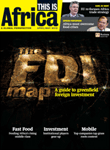Africa's beauty markets draw in Unilever, L'Oreal

Increased competition and R&D are helping multinationals tap into Africa's beauty and personal care markets.
Africa’s growing personal care and beauty markets are prompting ambitious innovation plans from two of the sector’s giants, Unilever and L'Oreal. Both are looking to capture the expanding middle classes. According to Richard Orendo Smith, chemical materials analyst at Frost and Sullivan, Africa is an exciting proposition for the beauty market, especially in the fast-growing economies such as Nigeria, as well as major markets including South Africa and Egypt.
While the personal care and beauty markets of South Africa and Nigeria are the biggest – valued at $2.1bn and $1.2bn respectively – the growth story is increasingly pan-African. Formal retail trade channels are expanding across the region, especially via the big South African retailers Shoprite, Pick ‘n Pay, Massmart, Spar and Metcash – whose own regional growth provides multinationals a route to market.
“Historically, South Africa has been a good market because, even if you aggregate across all ethnicities, there has been spending power there for some time,” says Geoff Skingsley, executive vice-president for the Africa and Middle East zone at L’Oreal. “What has changed is an awareness that other parts of Africa now have an emerging middle class, so the opportunity becomes much broader”.
When pondering which markets to enter, L’Oreal looks for a “decent size population, an emerging middle class, a minimum of infrastructure, and stability,” he adds. “There are more and more African countries that fall into that basket”. L’Oreal now has regional hubs in South Africa, Kenya and Ghana, and is in 15 markets in total. In the Middle East and Africa – the final frontier for L'Oreal - like-for-like sales grew at learly 15 percent in 2012 - the highest growth of any of its region, and up from 10.5 per cent in December 2011. Skingsley believes L’Oreal should grow at the twice the rate of the market “because we believe we are bringing new and better products”.
When it comes to product selection and innovation, certain traditional brands can have legs in African markets with minimal change. “We are developing libraries of options within our brands on a global scale and then selecting those options and tailoring them to [African] countries,” says Craig Luck, R&D director for skin products at Unilever. “It is important for brands to reach across, as far as they can, and speak to consumers in new ways. Who would have said that African men really appreciate and love a Vaseline for Men face range? But absolutely, they do.”
But tailored products are also needed to give brands a local touch – and Africa’s female consumers are attracting particular focus. L’Oreal and Unilever already have an established product range suitable for African and African-American consumers, including ‘Dark and Lovely’ by L’Oreal subsidiary SoftSheen-Carson, and Unilever’s Motions. Unilever has “a long history of a beauty brand speaking to African women” says Craig Luck.
They are also now investing in research and development to learn more about skin pigmentation and hair biology. “We do quite a bit of ‘first principle’ type studies where you are analysing the nature of skin and hair to try and make sure you have a solid bedrock of data on which products can be developed,” says Skingsley. “If you take make-up, to some degree it’s just a question of shades. You can adapt an international product and make sure you have the right shade choice. But if you take hair, you have to rip up the rulebook and start again. African hair is completely different from Caucasian hair, or Asian hair.”
Unilever’s R&D category director for personal care in Africa, Jennifer Cromie, agrees. “The biggest challenge for African women is getting a comb through their hair in the morning and getting into a style. That can be physically painful”. Hair biology differs across Africa too. “West African hair is coarser, thicker and harder to style and relax chemically while East African hair – notably in Kenya and Somalia – is finer and softer, sparser in some cases,” she says. Anti-ageing products need to be different too across groups as well. “Aging for Western women tends to be mainly around wrinkles or sagging skin. For Africans, it’s much more about dark spots and uneven complexion,” says L’Oreal’s Skingsley.
As well as scientific R&D, the two companies are building their knowledge of African consumers – and especially women – by developing closer ties with dermatologists, and hairdressers. “We need to understand the role that a lady’s hair stylist plays in her life, especially the African consumer,” says Jennifer Cromie. “They have a close relationship with their stylist. They trust them and take most of their advice.”
Companies seeking big profits in emerging markets may wonder if heated competition over mass-market consumer products can deliver sizeable enough revenues, and L’Oreal’s 2012 sales from the Middle East and Africa were still a modest €683m. But greater competition could grow the market. As Skingsley says: “Competition is good because if several of us are bringing innovations to consumers, then the markets themselves will grow. You get more natural market growth if you have two or three manufacturers bringing innovation to a market than just one”.
Access+
|
| Access+: A focus on education in Africa This Is Africa takes an in-depth look at the state of education in Africa Visit our Access+ page for: |
|
This is Africa is now on Twitter!
Most Viewed Content
-
10 recommendations
-
3 recommendations
-
2 recommendations
-
1 recommendations
-
1 recommendations




